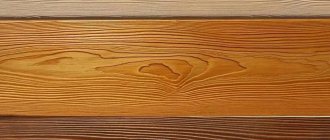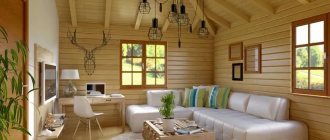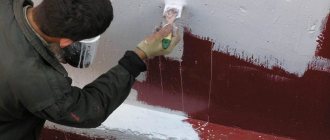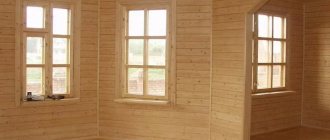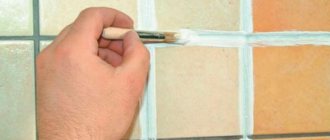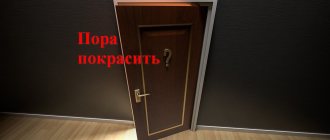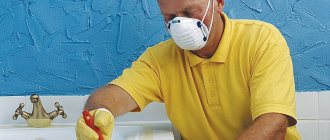Lining is one of the most popular materials for cladding rooms. It is used not only in dachas, verandas, but also in apartments. But the material has disadvantages. Over time, the aesthetic side changes, stains form, and the material requires updating. There are many ways to give it a fresher and more aesthetic look. This article describes in detail what to do if the lining has changed and lost its attractive appearance, and recommendations from experts are given.
Processing value
Lining is a material made from sheet wood . It ignites quickly. Even expensive coatings will not provide a guarantee against fires, but there are protective agents - fire retardants. Their task is to increase the protection of the material. After some time, it begins to deteriorate, become covered with dark spots, and rot. An antiseptic will help prevent or slow down an already existing process. In this case, the material does not need to be painted, but it is necessary to use an antiseptic.
Attention
The paint will protect against any damage. The coating is located on a thick layer of wood. It takes the blow and does not allow the material itself to be destroyed.
In the sun, wood darkens, and the protective coating repels it and preserves the shade of the wood. Colorless varnishes not only shine, but can change the color of the material (what to do if the lining turns yellow and how to avoid the problem?). The best treatment method is to apply an acrylate paint coating. It will renew the material, while the varnished panels will retain their color and decorativeness. The coating extends the service life to 8-10 years (you can find out how to correct defects and repair the lining here).
Paint with oil paint
This method is radical, because thick oil paint covers the wood structure and natural shade, and has an unnatural shine. But at the same time, this paint protects well from moisture, so it is ideal for external work. This coating requires a long time to dry and air, as the paint has a pungent odor. This coating should be updated every 5-6 years.
Application is identical to acrylic coating, only painted in dry weather.
Renewing old sheathed walls
There are several ways to update:
- Paint it.
- Plaster with sandpaper, then cover with acrylic.
- Paint with varnish.
Varnishing is the most common processing method. Wood is often used in construction, so polishing is a natural way to make your home look beautiful and extend its life. The varnish coating improves the condition of the entire finishing material.
Before you start painting, you need to determine the concept of the interior and its color.
Darkened pine paneling is initially coated with an antiseptic and then with oil paint. Acrylic scuba tanks are often used . The material will serve again if it is updated with varnishing. Oil paint will make the coating shiny, but over time it will still lose color and will need updating. Acrylate paint provides resistance to weather conditions. The surface is less susceptible to external destruction. This coating has a service life of up to ten years.
To ensure a uniform color, first stir the paint well and then apply it to the surface.
Important
To understand whether the tone is suitable, you need to make a test stroke on the lining. This will let you know if the coating needs to be thinned with white. If you process wood, you must first prime it with an antiseptic. It will help protect the product from fungus, since old materials are prone to rotting.
If the previous owners have already painted the lining, then there is no point in covering it with varnish - the old lining needs to be replaced or coated with new paint (we talked about how to practically and beautifully lining the inside of a room with lining, in this article). The result will look harmonious if the color fits into the interior design. The darkened area and places where the paint has peeled off must be treated. It is better to choose neutral tones, but you can resort to decoration in any color.
In a room at the dacha
- Before work, treat the surface with a primer, then with an antiseptic.
- Dry for two days.
- The boards are mounted, varnished and painted.
It is better not to change the color of the material . You can coat it with varnish - the lining will shine: you get a glossy surface. Acrylate varnishes are used for interior work, which preserves the color of wood and protects it from fading in the sun.
In the bath and steam room
There is no need to use regular wood varnish, as it is sensitive to high temperatures. It is recommended to use imported and protective products. Protective anti-varnish is suitable for treating surfaces in baths and steam rooms. Antivarnish can be colorless or tinted.
The coating is applied in two layers. The first one, if it is tinted, is diluted with water to twenty percent. If the composition is colorless, the action is skipped. The second layer is applied continuously. To see how the product applies to the lining, it is better to apply it to a separate board.
The treated surface almost does not absorb water, which increases its service life. The composition contains antifungal components. The product does not emit toxic fumes and is safe.
How to apply Aqualak:
- First, completely clean and plaster the surface. If a protective varnish has already been applied, the wood must first be sanded. This will help avoid contact of funds.
- Apply the first coat with a roller or brush.
- After forty minutes, apply a second coat. If the drying time exceeds 40 minutes, and the surface is completely dry, then when applying you need to rub the material into the wood.
Re-treatment can be done after three to four years.
Read about how to properly clapboard walls in a bathhouse here.
Inside the house
Stages of painting inside the house:
- Clean and prepare the paneling.
- Degrease the surface. Use an alkaline solution.
- Sand the wood with pumice.
- Color. Apply with a brush in a thin layer. To avoid drips, paint from top to bottom.
After processing, you can start decorating (you can see the best ideas and options for decorating walls with clapboard here).
Painting lining at the dacha: types of coatings, interesting ideas, technology
The interior decoration of a country house must be durable, safe and durable. And if in winter it is empty and not heated, then it is also moisture resistant, since the risk of condensation in this case is very high. Not every material can cope with such tasks, however, if you properly process and decorate natural wood lining, it will last for decades.
Depending on how you paint the lining inside your country house, it will have a different appearance: it will retain its natural pattern and shade or take on a new one. And protective compounds for impregnating wood improve its performance characteristics.
Restoration of varnished panels
The quality of the coating will depend on the degree of opacity required to obtain the walls. If you do not need to completely cover the wood structure, it is better to sand off the varnish and rub in the coating. You can use impregnation to preserve the wood texture .
Attention
If preservation of the structure is not required, then nothing needs to be removed. Acrylic paints with high adhesion adhere well to all surfaces and are quickly tinted to any shade. You can use polyurethane tinted enamel, but walls with such a coating will be very shiny, so this method is not for everyone.
Secrets of decorative wood staining: techniques and tricks
City dwellers want to preserve the natural color of wood as much as possible. For those for whom wood in the house is a boring everyday thing, paint the interior lining in some unusual color. Modern paintwork materials allow you to achieve different effects. For example, textured or brushed lining, but in two colors. This technique is often used in loft style interiors.
Brushed lining in two colors is an excellent choice for decorating walls
The trick is to apply two layers of different colors. The first layer is a dark color, the second is a light or brighter color. After playing with colors and the order of their application, you can create your own version. Watch the video - how to get lining brushed in two colors.
Painting in two colors may not be the same. You can make the recesses a darker color, and only slightly tint the face (front part) or do everything exactly the opposite. The result is a striped wall made of clapboard - the effect of a slatted wall.
Adviсe
- Do not use a thick layer, as it will blur and the service life will be short. It is better to paint in several thin layers.
- Use thin brushes in hard-to-reach places.
- Use a paint roller as it will not leave lint.
- Each product must be applied to the lining in several layers. Usually one or two, but it’s better to check with the store.
- When processing, move the brush along the board without tearing it off. Only the tips of the fibers should touch the lining. There is no need to press with great force.
It will be more difficult to update old lining on a terrace or on a cold balcony, so it is worth purchasing a special product that is resistant to temperature changes (how to beautifully cover a balcony or loggia with lining?). When processing building materials in a country house or in a heated room with normal humidity, no special requirements are imposed. It is enough that the materials to be painted are dry.
How to update the lining in a bathhouse
The main problem that can appear on the wooden finishing inside the bathhouse is blackening. The influence of hot steam, constant humidity and the use of brooms have a negative effect on the finish, and the sweat absorbed into it only enhances this effect.
The steam room places too strict demands on the quality of finishing; there is no place for varnishes, paints and other types of finishing coatings, only pure wood. And when deciding how to update the lining in the bathhouse, you need to take this fact into account. If the lining in the bathhouse has turned black just a little, you can get rid of the stains using detergents. The whole procedure boils down to:
- Clean surfaces using a sponge and a specialized water-based detergent.
- After complete drying, paraffin oil is applied to dry and clean wood, evenly distributing it over the surface. Not only the walls are impregnated with oil, but the floor, ceiling, benches and all wooden surfaces.
If the lining of the bathhouse is so blackened that simple treatment cannot save the situation, before updating the lining in the bathhouse with solutions, treat the entire surface with fine sandpaper, removing the entire damaged layer.
Precautions during operation
When working with varnishes, observe safety precautions. Organic solvents are highly flammable, so do not use open flames or smoke. The room must have effective natural or forced ventilation, since the evaporation of volatile compounds in the air increases the level of toxic substances. When using the sprayer, wear a respirator or bandage to protect the respiratory system.
All materials are stored separately, avoiding places with direct sunlight and away from heating devices.
Choosing material for cladding the balcony
Lining made from coniferous trees (cedar, larch, pine) is used for both internal and external cladding.
Pine wood is very durable, although its color may darken over time. In addition, thanks to resins, pine lining is not subject to rotting. Cedar boards are recognized as one of the most wear-resistant. However, its main drawback is its high cost.
The temperature on glazed loggias and balconies in hot weather sometimes rises to 50-60 C°. Therefore, if the balcony is located on the sunny side, pine and cedar lining cannot be used for external and internal cladding under any circumstances, because resin may be released on the surface of the boards when heated.
Eurolining made of hardwood (aspen, linden, oak, alder) is used in most cases for interior decoration of balconies.
The most budget options are alder and aspen. However, they do have minor drawbacks. Firstly, eurolining made from these types of wood may darken over time. Secondly, alder has relatively high thermal conductivity.
Linden lining is the most popular and, perhaps, ideal option for interior lining of a balcony. Linden wood has a pleasant light golden color that does not change over time.
In addition, you do not have to treat it with impregnations and varnishes. Linden lining does not overheat, does not swell and practically does not contain knots. In addition, it has high sound insulation properties. And this is especially true when it comes to a balcony.
What type of eurolining is suitable for a balcony?
There are three classes of eurolining:
- Grade A – these are boards with virtually no knots or core on the surface. The surface of class A eurolining has a uniform shade and is ideally smooth.
- Grade B means that a small number of knots are allowed on the surface, the size of which should not exceed 15-20 mm. These are high quality boards with good performance properties.
- Grade C – boards with knots up to 25 mm in size, blind holes, stripes and recesses.
If your budget allows, then it is better to use high-quality class A eurolining as upholstery, since it is most resistant to damage and harmful environmental factors.
Grade B is slightly inferior in performance characteristics to class A; it can be given a solid four plus. This type of eurolining is cheaper. In popularity it is not inferior to class A.
Class C boards, which are the most budget option, are used least often as a facing material for balconies.
It is definitely impossible to answer the question which eurolining is best for a balcony. After all, everything depends not only on the wood and type of material, but also on the climate zone, as well as on whether the balcony is located on the sunny side or not. Be sure to consider these factors.
